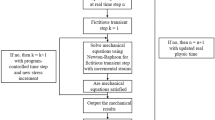Abstract
The track geometry created with laser metal deposition (LMD) is influenced by various parameters. In this case, the laser power has an influence on the width of the track because of an increasing energy input. A larger melt pool is caused by a rising temperature. In the case of a longer welding process, there is also a rise in temperature, resulting in a change of the track geometry. This paper deals with the temperature profiles of different zigzag strategies and spiral strategies for additive manufacturing. A two-color pyrometer is used for temperature measurement on the component surface near the melt pool. Thermocouples measure the temperatures in deeper regions of a component. The welds are located in the center and in the edge area on a test part to investigate the temperature evolution under different boundary conditions. The experiments are carried out on substrates made from mild steel 1.0038 and with the filler material 316L. The investigations show an influence on the temperature evolution by the travel path strategy as well as the position on the part. This shows the necessity for the development and selection of build-up strategies for different part geometries in additive manufacturing by LMD.











Similar content being viewed by others
References
Graf B, M Schuch, R Kersting, A Gumenyuk (2015) Additive process chain using selective laser melting and laser metal deposition. Lasers Manuf Conf 2015
Vayre B, Vignat F, Villeneuve F (2012) Designing for additive manufacturing. Proc CIRP 3:632–637
DMG MORI, Hoedtke GmbH & Co. KG - Generative Komplettbearbeitung in Fertigteilqualität“. [Online]. Verfügbar unter: http://de.dmgmori.com/fachpresse/advanced-technologies/hoedtke-gmbh---co--kg---generative-komplettbearbeitung-in-fertigteilqualitaet/385532
DMG MORI, Additive manufacturing eröffnet neue Designmöglichkeiten in der Herstellung von 3D-Bauteilen. [Online]. Verfügbar unter: http://de.dmgmori.com/fachpresse/advanced-technologies/additive-manufacturing/441798
Graf B, Gumenyuk A, Rethmeier M (2012) Laser metal deposition as repair technology for stainless steel and titanium alloys. Phys Proc 39:376–381
Kaierle S, Barroi A, Noelke C, Hermsdorf J, Overmeyer L, Haferkamp H (2012) Review on laser deposition welding: from micro to macro. Phys Proc 39:336–345
Khazan P, Stroth M, Freiße H, Köhler H (2014) Mechanical properties of large three-dimensional specimens build through direct powder deposition. Adv Mater Res 1018:525–532
Graf B, Ammer S, Gumenyuk A, Rethmeier M (2013) Design of experiments for laser metal deposition in maintenance, repair and overhaul applications. Proc CIRP 11:245–248
Cao Y, Zhu S, Liang X, Wang W (2011) Overlapping model of beads and curve fitting of bead section for rapid manufacturing by robotic MAG welding process. Robot Comput Integr Manuf 27(3):641–645
Li Y, Ma J (1997) Study on overlapping in the laser cladding process. Surf Coat Technol 90:1–5
Petrat T, Graf B, Gumenyuk A, Rethmeier M (2015) Build-up strategies for generating components of cylindrical shape with laser metal deposition. Lasers Manuf Conf 2015
Rombouts M, Maes G, Hendrix W, Delarbre E, Motmans F (2013) Surface finish after laser metal deposition. Phys Proc 41:803–807
Tabernero I, Lamikiz A, Martínez S, Ukar E, Figueras J (2011) Evaluation of the mechanical properties of Inconel 718 components built by laser cladding. Int J Mach Tools Manuf 51(6):465–470
Siemens Industry Software GmbH, NX Hybrid additive manufacturing—the new art of manufacturing—going beyond 3D printing. [Online]. Verfügbar unter: https://www.plm.automation.siemens.com/de_de/products/nx/for-manufacturing/cam/hybrid-additive-manufacturing.shtml
Petrat T, Graf B, Gumenyuk A, Rethmeier M (2016) Laser metal deposition as repair technology for a gas turbine burner made of inconel 718. Phys Proc 83:761–768
Foroozmehr E, Kovacevic R (2010) Effect of path planning on the laser powder deposition process : thermal and structural evaluation. Int J Adv Manuf Technol 51:659–669
Yadollahi A, Shamsaei N, Thompson SM, Seely DW (2015) Effects of process time interval and heat treatment on the mechanical and microstructural properties of direct laser deposited 316L stainless steel. Mater Sci Eng A 644:171–183
Farshidianfar MH, Khajepour A, Gerlich AP (2016) Effect of real-time cooling rate on microstructure in laser additive manufacturing. J Mater Process Technol 231:468–478
Guo P, Zou B, Huang C, Gao H (2017) Study on microstructure, mechanical properties and machinability of efficiently additive manufactured AISI 316L stainless steel by high-power direct laser deposition. J Mater Process Technol 240:12–22
Zhong Y, Liu L, Wikman S, Cui D, Shen Z (2016) Intragranular cellular segregation network structure strengthening 316L stainless steel prepared by selective laser melting. J Nucl Mater 470:170–178
Cao J, Liu F, Lin X, Huang C, Chen J, Huang W (2013) Effect of overlap rate on recrystallization behaviors of laser solid formed Inconel 718 superalloy. Opt Laser Technol 45:228–235
Zhao X, Chen J, Lin X, Huang W (2008) Study on microstructure and mechanical properties of laser rapid forming Inconel 718. Mater Sci Eng A 478(1–2):119–124
Flynn JM, Shokrani A, Newman ST, Dhokia V (2016) Hybrid additive and subtractive machine tools—research and industrial developments. Int J Mach Tools Manuf 101:79–101
Wank A u. a. Closed-loop control tools for automated laser cladding processes
Bi G, Gasser A (2011) Restoration of nickel-base turbine blade knife-edges with controlled laser aided additive manufacturing. Phys Proc 12(1):402–409
Song L, Mazumder J (2011) Feedback control of melt pool temperature during laser cladding process. IEEE Trans Control Syst Technol 19(6):1349–1356
Acknowledgments
The authors would like to acknowledge the Federal Ministry of Education and Research (BMBF) for funding the research by their support program Wachstumskern Potenzial and the Federal Institute for Materials Research and Testing for support.
Author information
Authors and Affiliations
Corresponding author
Additional information
This article is part of the collection Welding, Additive Manufacturing and Associated NDT
Rights and permissions
About this article
Cite this article
Petrat, T., Winterkorn, R., Graf, B. et al. Build-up strategies for temperature control using laser metal deposition for additive manufacturing. Weld World 62, 1073–1081 (2018). https://doi.org/10.1007/s40194-018-0604-8
Received:
Accepted:
Published:
Issue Date:
DOI: https://doi.org/10.1007/s40194-018-0604-8




